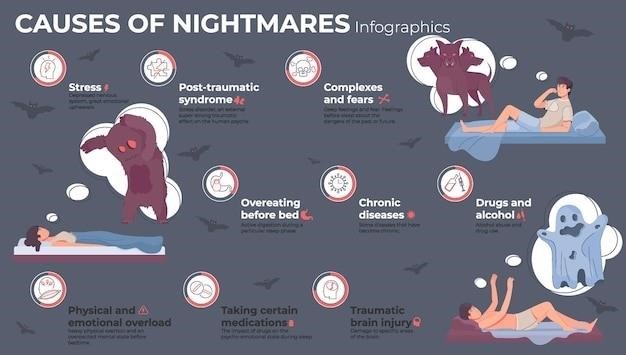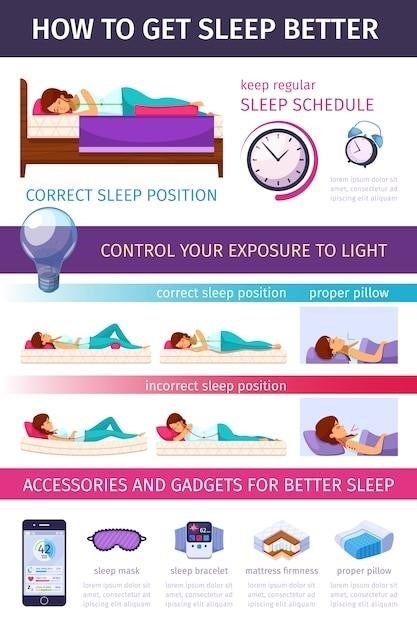
Seven Types of Rest⁚ An Overview
This overview explores seven distinct types of rest crucial for well-being⁚ physical (active and passive recovery), mental (managing cognitive overload), emotional (processing feelings), sensory (reducing overstimulation), creative (inspiring activities), social (nurturing connections), and spiritual (connecting to a higher purpose). Understanding these diverse forms of rest is key to holistic rejuvenation.
Physical Rest⁚ Active and Passive Recovery
Physical rest encompasses both active and passive recovery methods vital for bodily rejuvenation. Passive physical rest involves allowing the body complete inactivity, primarily through sleep or naps, enabling full recuperation from physical exertion and mental fatigue. Sufficient sleep is paramount; however, simply lying down or resting quietly can also contribute to passive recovery. This type of rest is crucial for muscle repair, immune system function, and overall energy restoration. Conversely, active physical rest focuses on gentle movements that promote circulation and flexibility without causing further strain. Activities like yoga, stretching, tai chi, or leisurely walks fall under this category; These activities help reduce muscle soreness, improve blood flow, and promote a sense of calm and relaxation. Finding a balance between passive and active physical rest is essential for optimal physical well-being, ensuring the body receives adequate recovery and avoids overexertion.
Mental Rest⁚ Managing Cognitive Overload
Mental rest is crucial for combating the effects of cognitive overload, a state often characterized by mental exhaustion, difficulty concentrating, and impaired decision-making. Unlike physical rest, mental rest doesn’t necessarily involve inactivity; rather, it focuses on shifting mental gears to reduce mental strain and promote mental clarity. Effective strategies include limiting exposure to mentally stimulating activities such as excessive screen time or demanding work tasks. Instead, incorporate activities that promote mental relaxation, such as mindfulness meditation, deep breathing exercises, or engaging in hobbies that require minimal cognitive effort but still offer a sense of accomplishment and enjoyment. Nature walks, listening to calming music, or simply spending time in quiet contemplation can also significantly contribute to mental rest. Regularly scheduling periods for mental rest is crucial for preventing burnout and maintaining optimal cognitive function, ensuring mental energy is replenished and mental clarity is restored. Prioritizing mental rest allows for improved focus, creativity, and overall emotional well-being.
Emotional Rest⁚ Expressing and Processing Feelings
Emotional rest involves creating space for processing and expressing emotions without judgment. It’s about acknowledging the full spectrum of human feelings—joy, sadness, anger, fear—and allowing oneself to experience them without suppression or avoidance. Bottling up emotions can lead to significant stress and mental health challenges. Strategies for emotional rest include journaling, engaging in creative expression (art, music, writing), or seeking support from trusted friends, family, or mental health professionals. Therapy can provide a safe and structured environment to explore and process emotions. Mindfulness practices can help individuals observe their emotions without getting carried away by them, fostering self-awareness and emotional regulation. Prioritizing emotional rest allows for greater self-understanding, improved emotional regulation, and stronger resilience in the face of life’s challenges. It’s about creating a nurturing environment for emotional well-being, fostering self-compassion and emotional growth.

Sensory Rest⁚ Reducing Overstimulation
In today’s fast-paced world, our senses are constantly bombarded with stimuli. Sensory rest is about intentionally reducing this overstimulation to allow our nervous system to recover. This might involve creating a quiet, dimly lit space, minimizing noise, and limiting exposure to bright screens. Spending time in nature, where the sensory input is often more calming and natural, can be incredibly restorative. Simple activities like taking a warm bath, listening to calming music, or engaging in gentle stretching can help to quiet the mind and soothe the senses. Mindful breathing exercises can also be beneficial in reducing sensory overload by grounding oneself in the present moment. The goal is to create a sensory environment that promotes relaxation and reduces the feeling of being overwhelmed. This type of rest is crucial for individuals who are highly sensitive to sensory input or those who work in environments with constant stimulation. Prioritizing sensory rest allows for improved focus, reduced anxiety, and enhanced overall well-being.
Creative Rest⁚ Engaging in Activities that Inspire
Creative rest isn’t about producing masterpieces; it’s about engaging in activities that spark joy and tap into your innate creativity. This type of rest replenishes your spirit and reduces mental fatigue by allowing for self-expression and exploration. Activities could include anything from painting or drawing to playing a musical instrument, writing poetry, gardening, cooking, or even engaging in a hobby like knitting or woodworking. The key is to choose activities that you find genuinely enjoyable and that allow you to lose yourself in the process. This isn’t about striving for perfection but about fostering a sense of playfulness and allowing your imagination to flow freely. Even simple activities like doodling or listening to inspiring music can be a form of creative rest. By engaging in creative pursuits, you can unlock feelings of accomplishment, reduce stress, and cultivate a deeper sense of self-awareness and personal fulfillment. The aim is to nurture your inner artist and allow your creativity to flourish, leading to a renewed sense of vitality and inspiration. This type of rest is essential for anyone feeling creatively drained or experiencing burnout.
Social Rest⁚ Nurturing Meaningful Connections
Social rest isn’t about attending every social gathering; it’s about selectively engaging in interactions that nourish your soul. It’s about choosing to spend time with people who uplift and support you, fostering genuine connections that leave you feeling energized rather than depleted. This might involve having a meaningful conversation with a loved one, sharing a meal with close friends, or engaging in activities that allow for genuine connection and shared experiences. Conversely, limiting time spent with individuals who drain your energy or engage in negative interactions is crucial for social rest. It’s about setting boundaries to protect your emotional well-being and prioritizing relationships that bring you joy and fulfillment. Social rest also involves engaging in activities that foster a sense of belonging and community, such as volunteering or participating in group activities aligned with your interests. The goal is to cultivate positive social connections that leave you feeling supported, appreciated, and connected to a larger community. This type of rest is essential for combating feelings of loneliness and isolation and fostering a sense of belonging and purpose.
Spiritual Rest⁚ Connecting to a Higher Purpose
Spiritual rest isn’t solely about religious practices; it encompasses connecting with something larger than yourself. This could involve meditation, prayer, spending time in nature, engaging in creative pursuits that inspire awe, or reflecting on your values and purpose; It’s about finding moments of stillness and reflection to reconnect with your inner self and your sense of meaning. This type of rest allows you to tap into a source of inner peace and strength, helping you feel grounded and centered. For some, it might involve attending religious services or engaging in spiritual practices, while others might find spiritual rest through activities like yoga, spending time in nature, or engaging in acts of service. The key is to find activities that foster a sense of connection to something greater than yourself, providing a sense of purpose and belonging. Spiritual rest is a powerful tool for reducing stress and anxiety, enhancing emotional resilience, and cultivating a deeper sense of self-awareness and inner peace. It’s about nurturing your spirit and fostering a sense of connection to something meaningful beyond your daily routines and responsibilities.
Restorative Rest⁚ Combining Different Types for Holistic Well-being
Restorative rest transcends simply addressing one type of tiredness; it’s about strategically combining various forms of rest to achieve holistic well-being. Think of it as a personalized blend, carefully crafted to address your unique needs. Perhaps a day might start with gentle yoga (active physical rest), followed by mindful meditation (mental and spiritual rest), and conclude with a relaxing evening spent with loved ones (social rest). The key is mindful integration. Recognizing your specific needs—are you mentally exhausted, emotionally drained, or physically depleted?—allows you to tailor your restorative rest strategy. This could involve a weekend getaway that incorporates nature walks (sensory and spiritual rest), time for creative pursuits (creative rest), and meaningful conversations with friends and family (social rest). The goal is to create a balanced approach, ensuring that all seven types of rest are incorporated into your routine, however frequently or infrequently is needed for your optimal functioning. This holistic approach promotes a deeper sense of rejuvenation and equilibrium, leaving you feeling truly restored and ready to face life’s challenges with renewed energy and focus. Prioritizing restorative rest is an investment in your long-term health and happiness.
